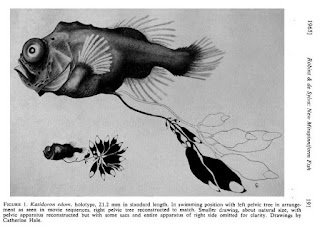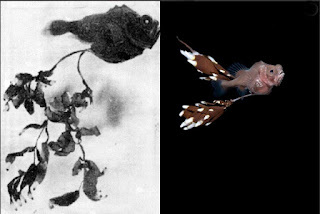THE SIPHONOPHORE FISH AND THE GIBBER FISH - TOTALLY DIFFERENT, YET ONE AND THE SAME!
 Asiphonophore fish depicted on an unofficial postage stamp released by the self-proclaimedGeorgian state of Abkhazia in 1998 (NB – its erstwhile genus has beenmisspelled on this stamp as Kasidorom,instead of Kasidoron) (public domain)
Asiphonophore fish depicted on an unofficial postage stamp released by the self-proclaimedGeorgian state of Abkhazia in 1998 (NB – its erstwhile genus has beenmisspelled on this stamp as Kasidorom,instead of Kasidoron) (public domain)
Appearancescan deceive, in more ways than one, as exemplified here by the truly remarkablecase of two very different fishes that turned out to be one and the same. Letme explain.
In1965, a small but spectacular fish called Kasidoron edom was describedin a Bulletin of Marine Science paperby C. Richard Robins and Donald P. de Sylva from the University of Miami's Instituteof Marine Science (click here to access this paper). Sole memberof a totally new genus and taxonomic family(until a second, similar species, K. latifrons, was recorded in 1969, fromthe western Indian Ocean), it became known as the siphonophore fish.
 Drawings by Catherine Hale ofthe siphonophore fish, from the above-mentioned Bulletin of Marine Science
paper
by C. Richard Robins and Donald P. de Sylva (© CatherineHale/C. Richard Robins/Donald P. de Sylva/Bulletinof Marine Science – reproduced here on a strictly non-commercial fair use basisfor educational/review purposes only)
Drawings by Catherine Hale ofthe siphonophore fish, from the above-mentioned Bulletin of Marine Science
paper
by C. Richard Robins and Donald P. de Sylva (© CatherineHale/C. Richard Robins/Donald P. de Sylva/Bulletinof Marine Science – reproduced here on a strictly non-commercial fair use basisfor educational/review purposes only)
Thiswas due to its astonishing pelvic fins. These were greatly modified, the third ray in each one havingtransformed into a long, multi-branched tree-like organ dubbed the pelvic tree,hanging underneath its body, terminating in a series of luminous(?), leaf-like sacs, and closely resembling the tentacular appendagesof those superficially jellyfish-like composite creatures the siphonophores(exemplified by the famous Portuguese man-o'-war Physalia).
Knownat that time only from waters of around 6-165 ft depth, about 150 miles east ofFlorida's Cape Canaveral and northeast of Bermuda, this 1.25-in-longvelvet-black fish attracted appreciable interest, on account of its conjoinedpelvic fins' unique, extraordinary structure. This was assumed to be a devicefor warding off predators, as they would be likely to mistake its harmless formfor the deadly stinging tentacles of genuine siphonophores.
 Two siphonophore fish photographsdiscovered by me recently
here
on the Quorawebsite (No copyright/ownership details for them are given there, and despite considerableonline searches I have been unable to locate any either, so I am including thesephotos on a strictly non-commercial Fair Use basis for educational/review purposesonly)
Two siphonophore fish photographsdiscovered by me recently
here
on the Quorawebsite (No copyright/ownership details for them are given there, and despite considerableonline searches I have been unable to locate any either, so I am including thesephotos on a strictly non-commercial Fair Use basis for educational/review purposesonly)
Aftera time, however, the remainder of this fish's anatomy began to receiveattention too, and researches ultimately disclosed that in spite of itsdistinctive appearance the siphonophore fish was not a new species at all.
Onthe contrary, it was unmasked as the hitherto-unknown juvenile form of an oddlittle species called the gibber fish (aka gibberfish) Gibberichthyespumilus, which had been formally described and named in 1933. It had beendiscovered in the waters around Bermuda and the Bahamas.
 Sketch of the gibber fish G. pumilus (Haplochromis/Wikipedia – publicdomain); click
here
to view a colour photograph of a gibber fish.
Sketch of the gibber fish G. pumilus (Haplochromis/Wikipedia – publicdomain); click
here
to view a colour photograph of a gibber fish.
Previouslyknown only from four specimens, this deepwater denizen attains a total lengthof 4.5 in, and inhabits the western North Atlantic, as well as the SouthPacific waters close to the Samoan Islands. With a very large head, a deep,laterally flattened body, and perfectly normal fins lacking any vestige of itsjuvenile's astounding tentacle-impersonating pelvic tree, the gibber fish isplaced within a taxonomic family of its own, most akin to the squirrelfishesand slimeheads.
Moreover,as the second siphonophore fish species, K.latifrons, has also been reclassified as a gibber fish, it is now known as G. latifrons.
 The full set of unofficialAbkhazia postage stamps, which includes not only the siphonophore fish stamp(bottom left) but also a stamp depicting the hairy fish [see below for details](top left) (public domain)
The full set of unofficialAbkhazia postage stamps, which includes not only the siphonophore fish stamp(bottom left) but also a stamp depicting the hairy fish [see below for details](top left) (public domain)
Interestingly,a very similar scenario of extreme metamorphosis from juvenile to adult was more recently revealed with another enigmatic,highly distinctive little fish that had long puzzled ichthyologists – theso-called hairy fish Mirapinna esau. Youcan read about its own very intriguing history here on ShukerNature, and also here in an early cryptozoology articleof mine reproduced on ShukerNature.
This ShukerNatureblog article is expanded from my book TheEncyclopaedia of New and Rediscovered Animals.

Karl Shuker's Blog
- Karl Shuker's profile
- 45 followers



